Nageswaran Temple Kumbakonam: Abode of Lord of Divine Serpents
The Nageswaran Temple is a Hindu temple dedicated to Shiva as Nageswaran, the lord of the serpents. It is located in the town of Kumbakonam in Tamil Nadu, India. The temple is one of the most important Shiva temples in the region and is a popular pilgrimage destination.
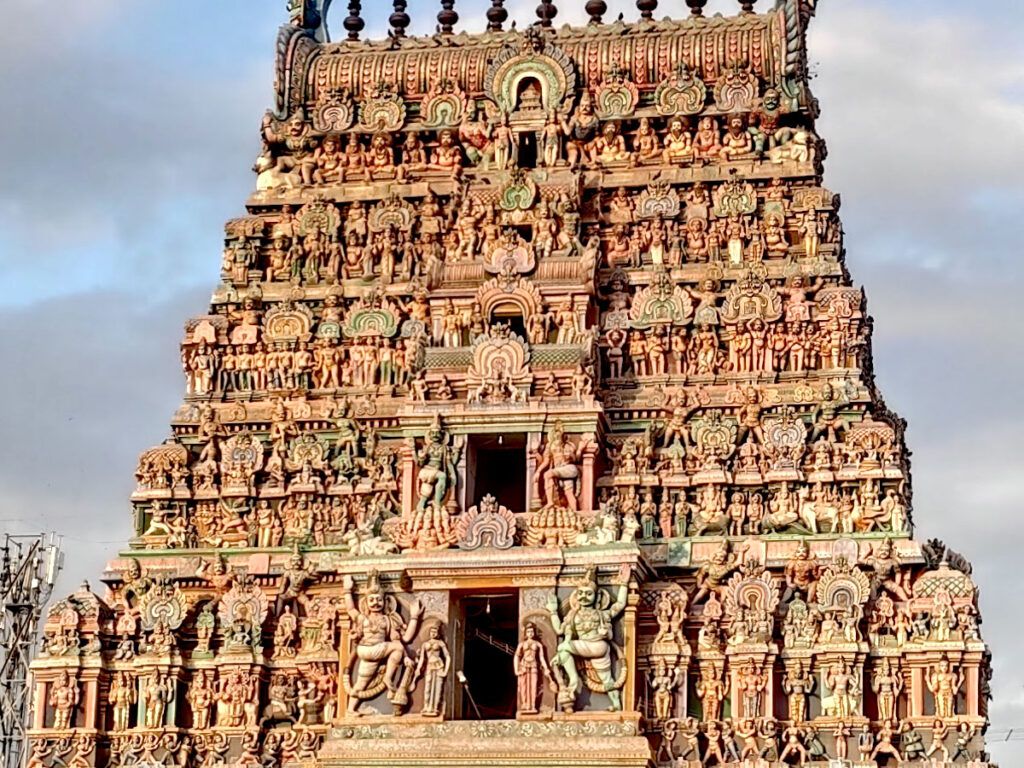
Contents
- 1 History of Nageswaran Temple Kumbakonam:
- 2 Legend of Nageswaran Temple Kumbakonam:
- 3 Significance of Nageswaran Temple Kumbakonam:
- 4 Myths of Nageswaran Temple Kumbakonam:
- 5 Specialty of Nageswaran Temple Kumbakonam:
- 6 Architecture Nageswaran Temple Kumbakonam:
- 7 Places to visit near Nageswaran Temple Kumbakonam:
- 8 FAQ:
- 8.0.1 When was Nageswaran Temple built?
- 8.0.2 What are the main features of Nageswaran Temple?
- 8.0.3 What are some of the important festivals celebrated at Nageswaran Temple?
- 8.0.4 How do I get to Nageswaran Temple?
- 8.0.5 What are the timings of Nageswaran Temple?
- 8.0.6 What are some tips for visiting Nageswaran Temple?
- 8.0.7 Which is the main temple in Kumbakonam?
- 8.0.8 What is Kumbakonam famous for?
- 9 How to reach Nageswaran Temple Kumbakonam:
- 10 Google Maps:
History of Nageswaran Temple Kumbakonam:
The Nageswaran Temple, also known as the Rahu Stalam and the Surya Kottam, is a Hindu temple dedicated to the deity Shiva, located in Thirunageswaram, a village in the suburbs of Kumbakonam, a city in the Thanjavur district of Tamil Nadu, India. It is significant to the Hindu sect of Saivism as one of the temples associated with the nine Navagraha planets. Shiva is worshiped as Naganathar, or the lord of serpents, and is represented by the lingam. His consort Parvati is depicted as Piraisoodi Amman.
The temple is believed to have been built by the Chola king Aditya Chola I in the 9th century A.D. It is a masterpiece of Chola architecture and is known for its intricate sculptures and its unique astronomical features. The temple is one of the few temples in India that is aligned in such a way that sunlight falls on the sanctum sanctorum for three days during the Tamil month of Chithirai (April-May).
The temple is also home to a shrine dedicated to Rahu, one of the nine Navagrahas. Rahu is believed to be a demon who was beheaded by the god Vishnu. According to legend, Rahu was so angry that he swallowed the sun and moon, causing an eclipse. Vishnu then restored the sun and moon to their rightful places, but Rahu was left with only his head. Rahu is believed to cause eclipses and other misfortunes, and he is often worshiped to appease him.
The Nageswaran Temple is a popular pilgrimage destination for Hindus from all over India. The temple is also a popular tourist destination, and it is often visited by travelers who are interested in Chola architecture and astronomy.
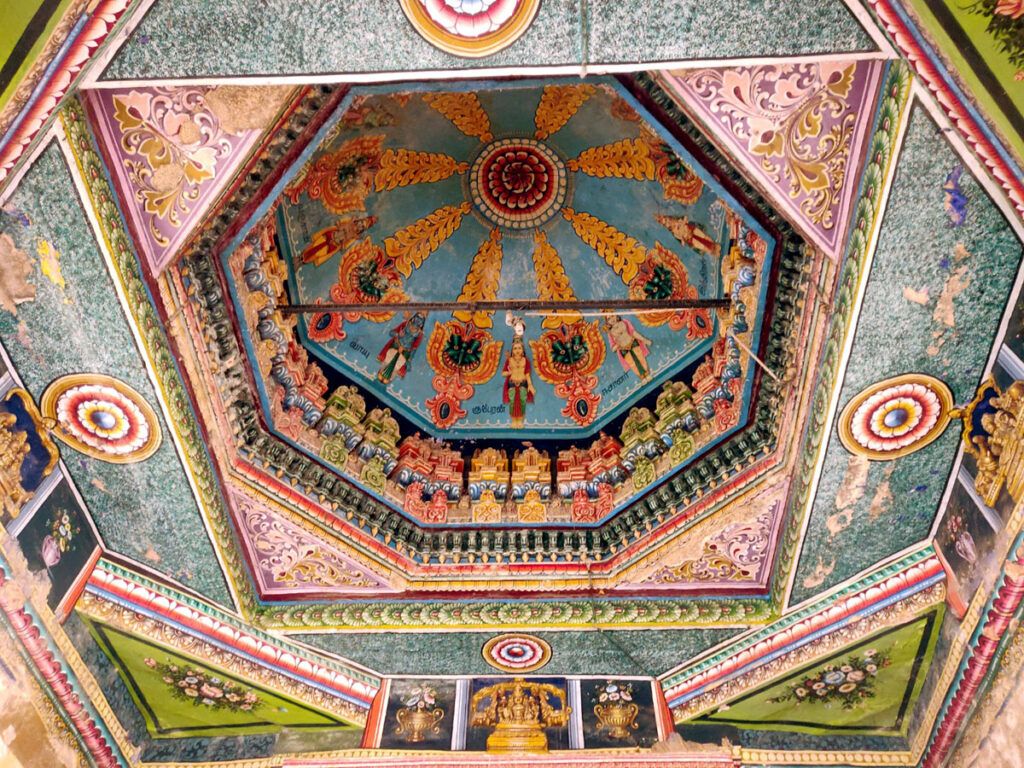
Legend of Nageswaran Temple Kumbakonam:
The legend of Nageswaran Temple in Kumbakonam, India, tells the story of a powerful snake named Vasuki. Vasuki was the king of the Nagas, a race of serpents in Hindu mythology. He was a loyal servant of Vishnu, the preserver of the universe.
One day, Vishnu was engaged in a battle with the asura (demon) Mura. Mura was a powerful enemy, and Vishnu was struggling to defeat him. Vasuki saw Vishnu’s plight and decided to help. He coiled himself around the world and formed a bed for Vishnu to rest on. Vishnu then used his Sudarshana Chakra (a discus) to defeat Mura.
Vishnu was grateful for Vasuki’s help, and he promised to reward him. Vishnu told Vasuki that he could choose any boon that he desired. Vasuki thought for a moment, and then he said, “I desire to have a temple built in my honor.” Vishnu agreed, and he ordered the construction of the Nageswaran Temple.
The temple was built in the 10th century by the Chola king Rajaraja Chola I. It is dedicated to Vasuki, and it is one of the most important snake temples in India. The temple is located in the town of Kumbakonam, which is about 250 kilometers from Chennai.
Significance of Nageswaran Temple Kumbakonam:
- It is one of the Pancha Bootha Sthalams, temples dedicated to the five elements of nature.
- It is an ancient temple, believed to have been built in the 10th century.
- It is a beautiful temple, known for its architecture and sculptures.
- It is a significant pilgrimage site for Hindus.
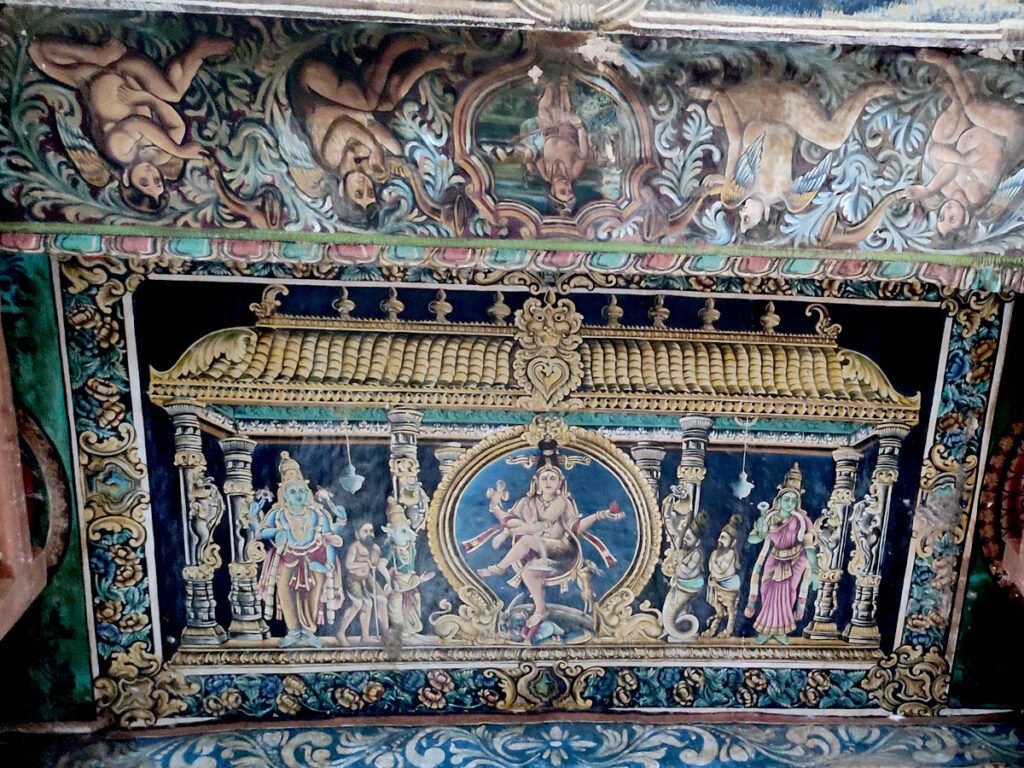
Myths of Nageswaran Temple Kumbakonam:
The temple is home to a number of myths and legends. One of the most famous myths tells the story of how the temple was built. According to the myth, Rajaraja Chola I was once bitten by a snake and was cured by Naga. In gratitude, the king built the temple to honor Naga.
Another myth tells the story of how the temple is said to be able to grant wishes. According to the myth, if a person prays to Naga with a sincere heart, their wish will be granted.
The myth of the snakebite: According to this myth, Rajaraja Chola I was once bitten by a snake. He was cured by Naga, who appeared to him in a dream. In gratitude, the king built the temple to honor Naga.
The myth of the wishing well: According to this myth, the tank in front of the temple is a wishing well. If a person prays to Naga with a sincere heart, their wish will be granted.
The myth of the seven-headed serpent: According to this myth, Naga is a seven-headed serpent. The seven heads represent the seven chakras of the human body.
Specialty of Nageswaran Temple Kumbakonam:
- The temple is dedicated to Shiva in the form of a snake. This is a unique form of Shiva worship that is not found in many other temples.
- The temple is home to over 1000 snake sculptures. These sculptures are carved in stone and bronze and depict a variety of snakes.
- The temple hosts an annual snake festival. This festival is a popular event that attracts people from all over India.
Some Interesting Facts about Nageswaran Temple:
- The temple is believed to have been built in the 10th century by the Chola king Rajaraja Chola I. However, there is evidence that suggests that the temple may have been built earlier, possibly in the 8th century.
- The temple is located on the banks of the Cauvery River. The river is considered to be sacred in Hinduism and is believed to have healing powers.
- The temple is a popular pilgrimage destination for Hindus from all over India. People come to the temple to worship Shiva and seek his blessings for good health and prosperity.
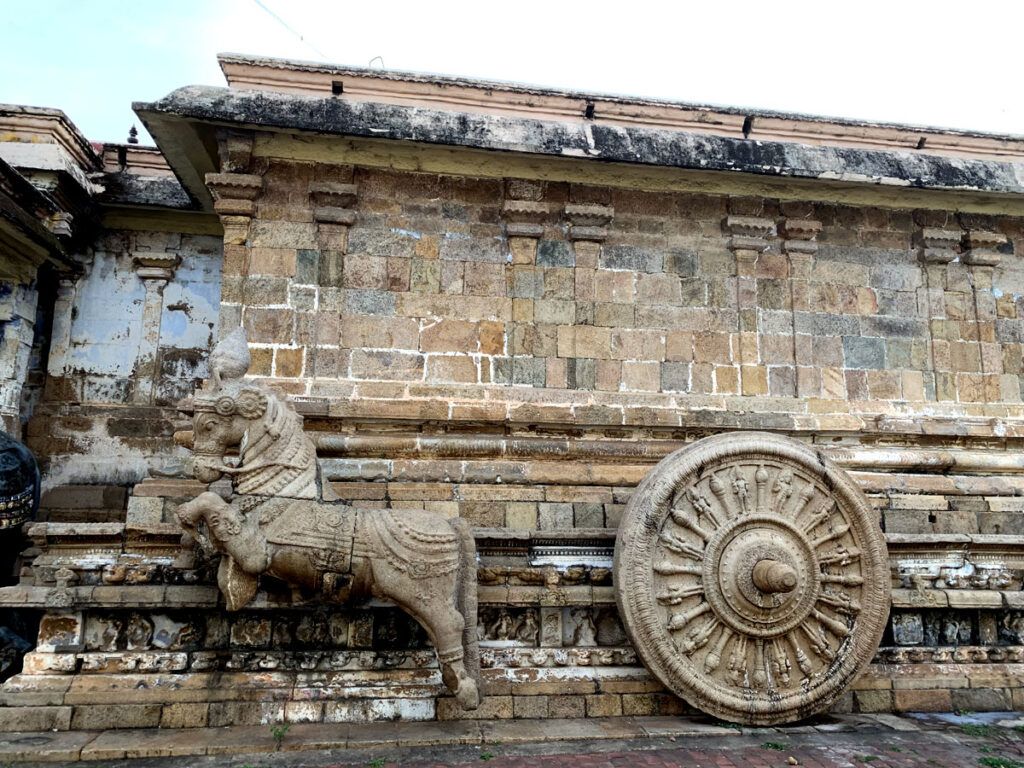
Architecture Nageswaran Temple Kumbakonam:
The Main Shrine
The main shrine of the temple is dedicated to Naga. The shrine is located in the center of the temple complex. The shrine is built in the rectangular shape and is made of granite. The shrine is decorated with intricate sculptures of gods, goddesses, and mythological creatures.
The image of Naga in the main shrine is made of bronze. The image is depicted in a reclining position. Naga is depicted with seven hoods. The hoods are decorated with gems and flowers.
The Gopurams
The temple has a number of gopurams (gateway towers). The main gopuram is located at the entrance to the temple complex. The gopuram is six-tiered and is over 60 meters tall. The gopuram is decorated with intricate sculptures of gods, goddesses, and mythological creatures.
The other gopurams in the temple complex are four-tiered. These gopurams are located at the entrance to the various shrines in the temple complex.
The Temple Garden
The temple has a temple garden, which is located to the north of the main shrine. The temple garden is home to a variety of plants and flowers. The temple garden is also a popular spot for meditation and prayer.
Other Features
The temple also has a number of other features, including:
- A Naga-Yakshi sculpture, which is located to the east of the main shrine. The Naga-Yakshi sculpture is a depiction of a snake woman.
- A tank, which is located to the south of the main shrine. The tank is believed to be sacred.
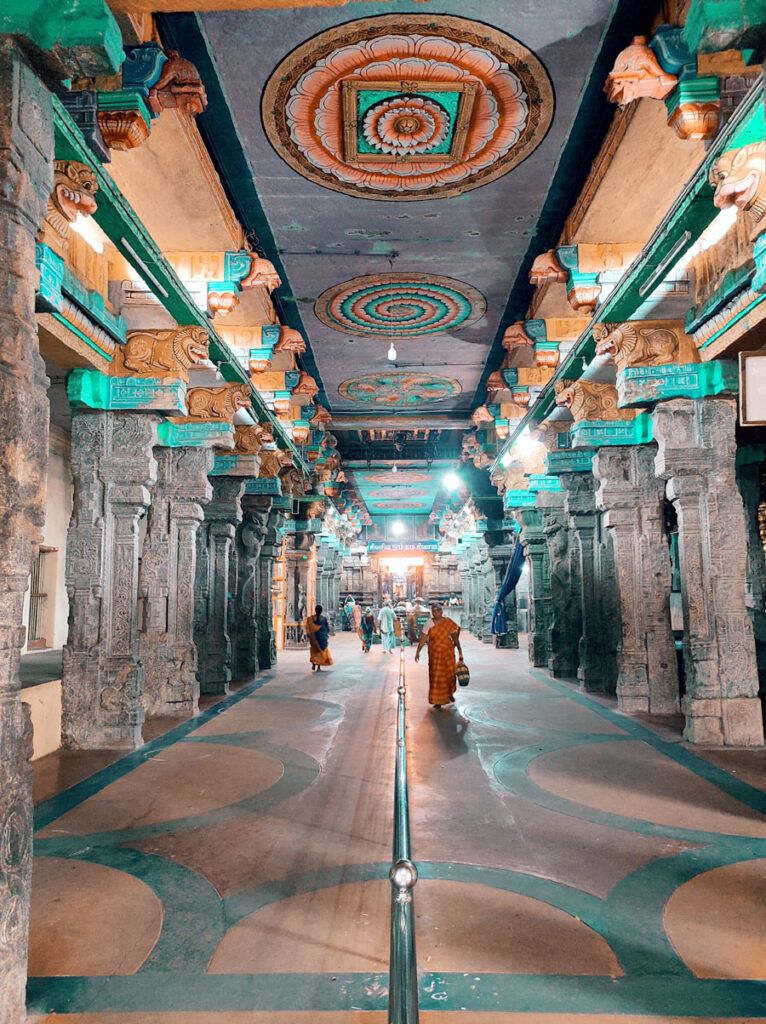
Places to visit near Nageswaran Temple Kumbakonam:
Sarangapani Temple: This is one of the Divya Desams, the 108 temples of Vishnu mentioned in the works of the Alvars. The Sarangapani Temple is dedicated to Lord Vishnu and is known for its beautiful architecture.
Kumbakonam Mahamaham Tank: This large temple tank is considered sacred, and it is associated with the Mahamaham festival that takes place once every 12 years. Pilgrims take a dip in the tank during this festival.
Adi Kumbeswarar Temple: Dedicated to Lord Shiva, this temple is one of the prominent Saivite temples in Kumbakonam. It is believed to be the oldest Shiva temple in the town.
Chakrapani Temple: Another Divya Desam, this temple is dedicated to Lord Vishnu in his form as Chakrapani. The temple is known for its intricate sculptures.
Ramaswamy Temple: This temple is dedicated to Lord Rama and is famous for its elaborate carvings depicting scenes from the Ramayana.
Uppiliappan Temple: Located in Thirunageswaram, a short distance from Kumbakonam, this temple is dedicated to Lord Vishnu. It is one of the 108 Divya Desams.
Swamimalai Murugan Temple: Situated near Kumbakonam, this temple is one of the six abodes of Lord Murugan. It is atop a hill, and visitors need to climb a flight of steps to reach the temple.
Darasuram Airavatesvara Temple: A UNESCO World Heritage site, this temple is known for its intricate carvings and is dedicated to Lord Shiva. It’s a little farther from Kumbakonam but worth a visit.
Mahalingaswamy Temple, Thiruvidaimarudur: This temple is dedicated to Lord Shiva and is associated with the legend of Lord Brahma seeking forgiveness.
Nellaiappar Temple: Located in Thirunelveli, it is dedicated to Lord Shiva and is known for its musical pillars.
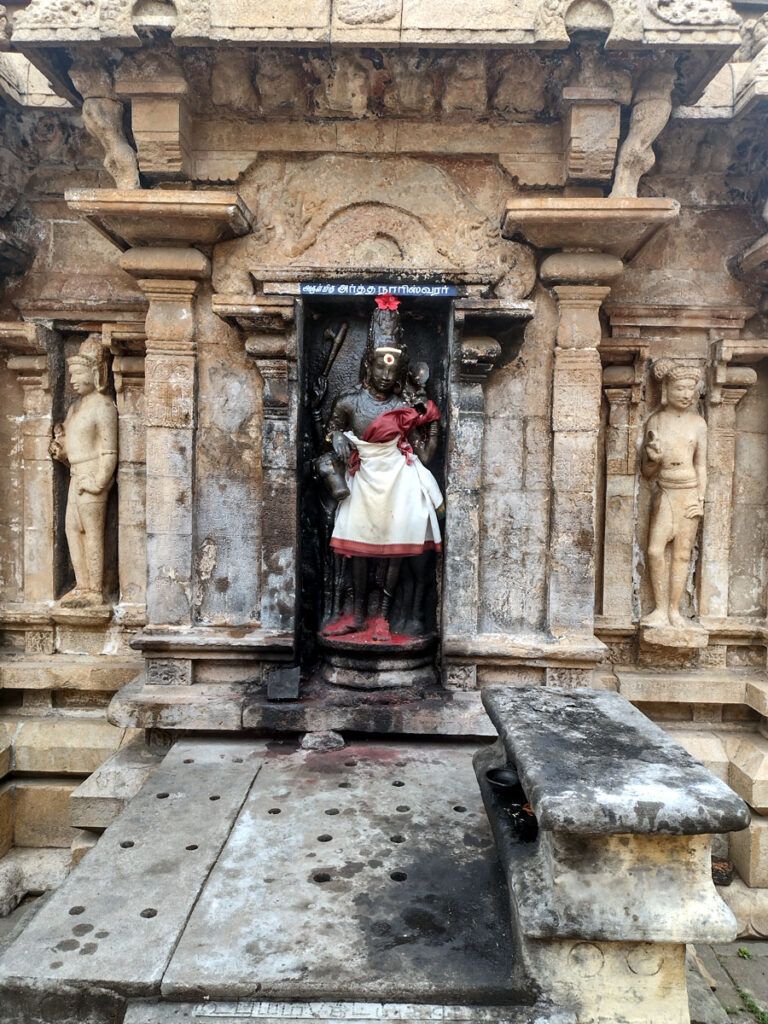
FAQ:
When was Nageswaran Temple built?
The exact date of construction of the temple is unknown, but it is believed to have been built over 1,000 years ago. The temple is thought to have been built by the Chola kings, who were patrons of Hindu temples.
What are the main features of Nageswaran Temple?
The temple is built in the Dravidian style of architecture. It has a five-tiered gopuram (gateway tower) that is over 50 meters tall. The temple also has a number of other shrines, including shrines dedicated to Vishnu, Shiva, and Parvati.
What are some of the important festivals celebrated at Nageswaran Temple?
Some of the important festivals celebrated at Nageswaran Temple include Naga Panchami, Vaikasi Visakam, and Navaratri. Naga Panchami is a festival that celebrates the serpent gods. Vaikasi Visakam is a festival that celebrates the birth of Vishnu. Navaratri is a nine-day festival that celebrates the victory of good over evil.
How do I get to Nageswaran Temple?
Nageswaran Temple is located in the town of Kumbakonam. Kumbakonam is well connected by road, rail, and air. The nearest airport is the Tiruchirapalli International Airport, which is about 100 kilometers from Kumbakonam.
What are the timings of Nageswaran Temple?
Nageswaran Temple is open from 6:00 AM to 12:00 PM and from 4:00 PM to 8:00 PM.
What are some tips for visiting Nageswaran Temple?
Here are some tips for visiting Nageswaran Temple:
- Wear comfortable shoes as you will be doing a lot of walking.
- Carry sunscreen and a hat to protect yourself from the sun.
- Bring a bottle of water to stay hydrated.
- Be respectful of the temple and its surroundings.
Which is the main temple in Kumbakonam?
Determining the “main” temple in Kumbakonam is subjective, as the city is home to numerous revered temples, each with its unique significance and historical importance. However, considering the factors of antiquity, architectural splendor, and religious significance, two temples stand out as prominent contenders for the title of Kumbakonam’s main temple:
- Adi Kumbeswarar Temple: This ancient temple, believed to be constructed in the 9th century, holds the distinction of being the oldest temple in Kumbakonam. It is dedicated to Lord Shiva, revered as the presiding deity of the city, and is renowned for its towering gopuram (gateway tower) and intricate carvings.
- Kasi Viswanathar Temple: This 16th-century temple is another prominent Shiva shrine in Kumbakonam. It is believed to be a replica of the famous Kashi Vishwanath Temple in Varanasi and is known for its serene atmosphere and its association with the sacred Mahamaham festival.
What is Kumbakonam famous for?
Kumbakonam is a vibrant city in Tamil Nadu, India, renowned for its rich cultural heritage, ancient temples, and exquisite craftsmanship. Here are some of the things that Kumbakonam is famous for:
- Temples: Kumbakonam is often referred to as the “Temple City” due to its abundance of Hindu temples, with over 188 temples within the municipal limits. These temples represent various architectural styles and are dedicated to a diverse pantheon of Hindu deities, making Kumbakonam a pilgrimage destination for devotees from around the world.
- Mahamaham Festival: Once every 12 years, Kumbakonam comes alive with the Mahamaham festival, a grand religious celebration that attracts millions of pilgrims. This festival commemorates the mythical event of the sacred nectar spilling onto Earth, and it involves a procession of deities, ritual bathing in the Mahamaham tank, and prayers for spiritual purification.
- Brass and Metal Craftsmanship: Kumbakonam has a long tradition of metalworking, and the city is renowned for its exquisite brass and metal sculptures. Artisans in Kumbakonam have mastered the art of metal casting, creating intricate figurines, vessels, and other decorative objects that are highly prized for their craftsmanship and artistry.
- Silk Weaving: Kumbakonam is a hub for silk weaving, with a rich history dating back to the Chola period. The city’s silk sarees, known for their vibrant colors, intricate designs, and luxurious feel, are highly sought after for their beauty and elegance.
- Filter Coffee: Kumbakonam is a haven for coffee enthusiasts, known for its unique “degree” system of preparing filter coffee. This method involves brewing coffee decoction in a specific number of “degrees,” resulting in a strong, aromatic, and flavorful beverage that is a local favorite.
- Betal Leaves: Kumbakonam is a major producer of betel leaves, known for their high quality and distinct flavor. Betel leaves are widely consumed in India for their medicinal properties and cultural significance, and Kumbakonam’s betel leaves are particularly prized for their freshness and aroma.
- Cultural Heritage: Kumbakonam is steeped in cultural heritage, with a rich tradition of music, dance, and literature. The city is home to renowned Carnatic musicians, Bharatanatyam dancers, and poets, and its cultural events are a vibrant part of its identity.
- Educational Institutions: Kumbakonam boasts a strong educational tradition, with several prestigious schools and colleges. The city’s educational institutions have produced many notable alumni in various fields, contributing to its reputation as a center of learning.
- Cuisine: Kumbakonam is renowned for its flavorful vegetarian cuisine, with a focus on fresh local ingredients and traditional cooking techniques. The city’s culinary delights include sambar, rasam, dosas, and filter coffee, offering a taste of authentic South Indian flavors.
- Tranquil Atmosphere: Despite its bustling religious and commercial activities, Kumbakonam retains a tranquil and serene atmosphere. The city’s temples, riverbanks, and leafy streets provide a welcome respite from the chaos of urban life, making it a place of spiritual solace and relaxation.
How to reach Nageswaran Temple Kumbakonam:
By Air:
The nearest airport is Tiruchirapalli International Airport (IATA: TRZ), which is approximately 91 kilometers away. From the airport, you can hire a taxi or use other local transportation services to reach Kumbakonam. Once in Kumbakonam, you can use local transportation to reach Nageswaran Temple.
By Train:
Kumbakonam has its own railway station, well-connected to major cities in Tamil Nadu and other parts of India. Check the train schedules and book tickets to Kumbakonam Railway Station. From there, you can use local transportation like auto-rickshaws or taxis to reach Nageswaran Temple.
By Bus:
Regular bus services connect Kumbakonam to various cities and towns in Tamil Nadu. You can check for buses to Kumbakonam Bus Stand and then use local transportation to reach the Nageswaran Temple.
By Road:
If you’re traveling by car, you can use navigation apps or maps to find the best route to Kumbakonam. Once in Kumbakonam, follow local directions or use GPS to reach Nageswaran Temple.
Local Transportation:
Within Kumbakonam, you can use local transportation options like auto-rickshaws or taxis to reach Nageswaran Temple. Most locals are familiar with the temple’s location and can provide directions.
